Restoration of a Large Sailing Model, 1
RESTORING AN ANTIQUE SAILING MODEL OF THE SCHOONER
SADIE MORSE
In the “ON THE WORKBENCH” section of the site, I’ve always highlighted a new project, L. A . Dunton. Emma C. Berry, Kate Cory. But I thought since I have been doing a lot of repair work lately, why not chronicle a repair project. I’ve left the comments option on for these posts, if you’d like to leave a question or comment. Tell me what you’re thinking. So, here is my latest big project:
The Restoration of the large Sailing Model, Sadie Morse.
Note: I undertook this project at the request of a private owner, not a museum or historical institution. He bought the model in “as is” condition at auction and wanted to have it repaired and stabilized. This is not a museum level conservation. The point of this repair was to make a visually acceptable restoration on an antique using reversible and non-reversible techniques and materials. So now, let’s have a look at Sadie.
PART ONE
FINDINGS
My initial examination of the model was at the home of its current owner. This model is fairly large, being 51-1/4” from the peak of the foc’sle deck to the taffrail and a bit over 5 feet tall. There was no original rigging left on the model and the rigging that was there was done by the client solely as a means of keeping the spars in place, temporarily.
Figure 1 Sadie, before repairs began.
The model portrays a vessel of the type that was very popular in the coastwise trade from the late 19th to the early 20th century. Typically vessels from this period and configuration were in the 60-90 foot range. My guess for the size of the ship this model represents would be about 75, or possibly 80 feet. And my estimate of its age puts it at about 1880 to the turn of the 20th century, or perhaps shortly thereafter. I believe the model is nearly that old, as well. There is a name hand written on the starboard quarterdeck topgallant rail. It reads, “Sadie Morse”. I did a quick internet search for vessels with that name, but found nothing. The client also searched and found a link to a family named Morse from Maine. And there was, indeed a girl named Sadie born into this family in the 1880’s. The family was also involved with ship and boat building in Maine, but there was no mention of a vessel named for the girl. As of the writing of this document, there has been no further information concerning the validity of the name as it pertains to a specific vessel.
CONDITION OF THE MODEL
Upon its arrival to my studio, I had a chance examine the entire model in detail and assess its condition, as well as form a plan for the repairs.
The first thing I noticed was the amount and condition of the paint. It was very clear that the current paint scheme is not the original. However, this was done a long time ago, as there is ample evidence of the paint breaking down, mostly I would guess, from the model not being adequately hydrated over its long life. One could suppose that the newer paint scheme was applied by someone other than the original builder/owner. And that is certainly possible. It is also just as likely to have been done by the builder. He (or she) may have had the model for so long that they tired of the original colors and gave it a look that suited their changing tastes. There really is no way to know what the truth about this is, except the one indisputable truth: This paint is old. The client and I agreed that the paint would be left as it is, with one exception. Sometime in the model’s life, a previous owner had the room the model occupied painted. The model must have been left uncovered because the foc’sle deck, the main deck, the quarterdeck and the top of the aft cabin were speckled with white paint. This was obviously cast off from a paint roller. This is the kind of damage that can happen very quickly and without the knowledge of the person causing it.
Figure 2 The broken garboard has been removed, exposing the frames. Note that, even in the photo, the paint looks dry.
CONDITION OF THE HULL
The hull is built plank on frame. The frames are roughly formed by steam bending and a number of them have hard bends in them, rather than smooth curves and beveled edges. They are attached to the keel by means of hide glue and wrought nails. Large amounts of hide glue was used in an effort to bind the ill-fitting frames to the keel. Hide glue is not meant to fill gaps and correct bad joinery. It gets its strength from solid surface to surface contact between the mating pieces. As a result, as long as the nails held, the frames held. But as the nails began to rust and corrode the weakened glue joints began to fail. I found many loose frames lying in the hold of the model. Moreover, the builder did not follow standard ship building practices when he built the hull. There are no clamps, stringers, ceiling planks or keelson to internally tie the structure together. What this means is that the hull is now held together by rusted nails and the very brittle glue of the outside planking. If you remove the planks, the frames will fall apart. Another issue related to the hull structure was the discovery of a missing section of the garboard plank on the starboard side of the model. About 5 inches aft of the forefoot, there was a 5” or 6” piece of the garboard plank missing. The break appeared to be quite old as the remaining edges were slightly rounded over and the bare wood was definitely not clean. All of the wrought nails holding this plank in place were rotted through and with frighteningly little effort the entire aft section of the plank came cleanly away from the model. This exposed the interior of the bottom of the model. Here, I made another discovery. The interior of the model from the floor of the frames up to the underside of the deck and from the break of the quarterdeck all the way to the transom was packed solid with nesting material of some rodent. It was not be a stretch of the imagination to think that the break in the garboard had a lot to do with these creatures choosing this model as a great place to raise a family. Fortunately for The client (who has had the model in his house) and for me, who has to clean the model, it was clear the nest was abandoned many years ago. I did, however, find a few almonds, still in their shells that were left behind.
Figure 3 A cozy little nest, for a while, anyway.
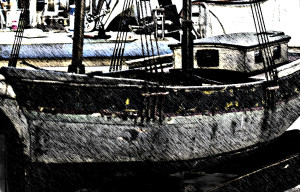
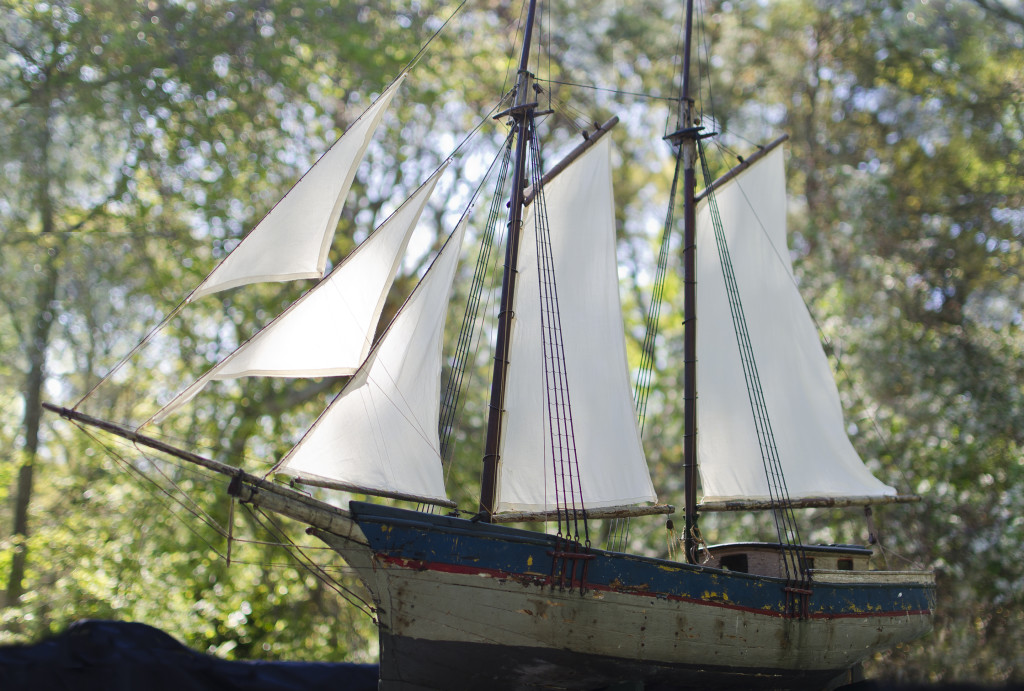
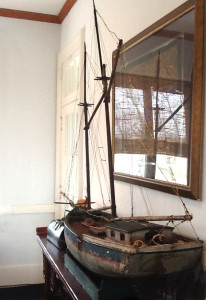
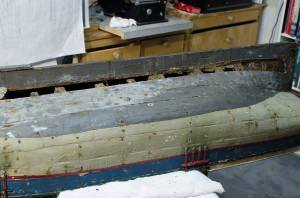
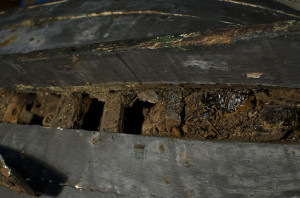

Leave a Reply